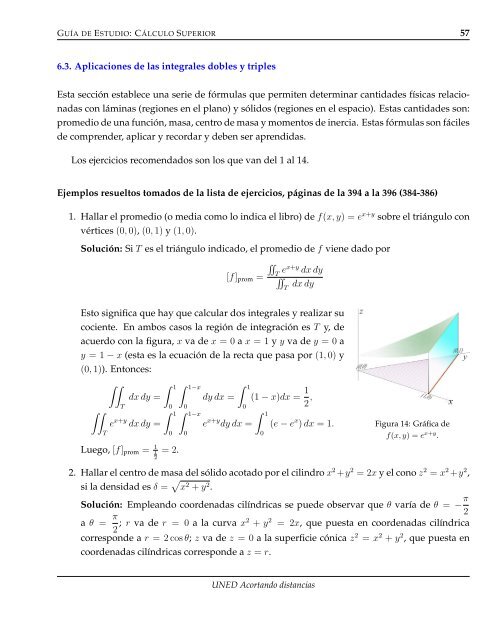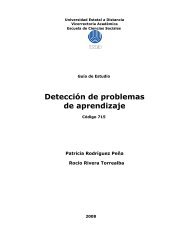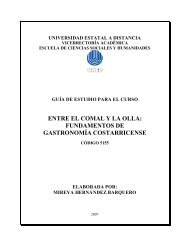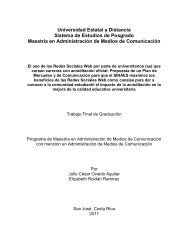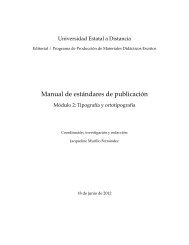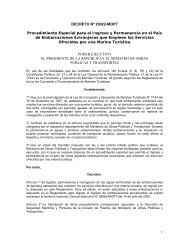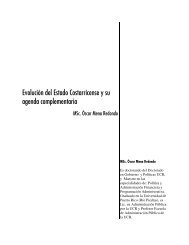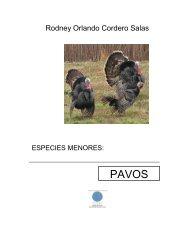GE3011 Cálculo Superior - Repositorio de la Universidad Estatal a ...
GE3011 Cálculo Superior - Repositorio de la Universidad Estatal a ...
GE3011 Cálculo Superior - Repositorio de la Universidad Estatal a ...
You also want an ePaper? Increase the reach of your titles
YUMPU automatically turns print PDFs into web optimized ePapers that Google loves.
GUÍA DE ESTUDIO: CÁLCULO SUPERIOR 57<br />
6.3. Aplicaciones <strong>de</strong> <strong>la</strong>s integrales dobles y triples<br />
Esta sección establece una serie <strong>de</strong> fórmu<strong>la</strong>s que permiten <strong>de</strong>terminar cantida<strong>de</strong>s físicas re<strong>la</strong>cio-<br />
nadas con láminas (regiones en el p<strong>la</strong>no) y sólidos (regiones en el espacio). Estas cantida<strong>de</strong>s son:<br />
promedio <strong>de</strong> una función, masa, centro <strong>de</strong> masa y momentos <strong>de</strong> inercia. Estas fórmu<strong>la</strong>s son fáciles<br />
<strong>de</strong> compren<strong>de</strong>r, aplicar y recordar y <strong>de</strong>ben ser aprendidas.<br />
Los ejercicios recomendados son los que van <strong>de</strong>l 1 al 14.<br />
Ejemplos resueltos tomados <strong>de</strong> <strong>la</strong> lista <strong>de</strong> ejercicios, páginas <strong>de</strong> <strong>la</strong> 394 a <strong>la</strong> 396 (384-386)<br />
1. Hal<strong>la</strong>r el promedio (o media como lo indica el libro) <strong>de</strong> f(x, y) = e x+y sobre el triángulo con<br />
vértices (0, 0), (0, 1) y (1, 0).<br />
Solución: Si T es el triángulo indicado, el promedio <strong>de</strong> f viene dado por<br />
<br />
T<br />
[f]prom =<br />
ex+y dx dy<br />
<br />
dx dy<br />
Esto significa que hay que calcu<strong>la</strong>r dos integrales y realizar su<br />
cociente. En ambos casos <strong>la</strong> región <strong>de</strong> integración es T y, <strong>de</strong><br />
acuerdo con <strong>la</strong> figura, x va <strong>de</strong> x = 0 a x = 1 y y va <strong>de</strong> y = 0 a<br />
y = 1 − x (esta es <strong>la</strong> ecuación <strong>de</strong> <strong>la</strong> recta que pasa por (1, 0) y<br />
(0, 1)). Entonces:<br />
<br />
T<br />
<br />
T<br />
dx dy =<br />
e x+y dx dy =<br />
Luego, [f]prom = 1 1<br />
2<br />
1 1−x<br />
0 0<br />
1 1−x<br />
0<br />
= 2.<br />
0<br />
dy dx =<br />
1<br />
0<br />
e x+y dy dx =<br />
T<br />
(1 − x)dx = 1<br />
2 ,<br />
1<br />
0<br />
(e − e x ) dx = 1. Figura 14: Gráfica <strong>de</strong><br />
f(x, y) = e x+y .<br />
2. Hal<strong>la</strong>r el centro <strong>de</strong> masa <strong>de</strong>l sólido acotado por el cilindro x 2 +y 2 = 2x y el cono z 2 = x 2 +y 2 ,<br />
si <strong>la</strong> <strong>de</strong>nsidad es δ = x 2 + y 2 .<br />
Solución: Empleando coor<strong>de</strong>nadas cilíndricas se pue<strong>de</strong> observar que θ varía <strong>de</strong> θ = − π<br />
2<br />
a θ = π<br />
2 ; r va <strong>de</strong> r = 0 a <strong>la</strong> curva x2 + y 2 = 2x, que puesta en coor<strong>de</strong>nadas cilíndrica<br />
correspon<strong>de</strong> a r = 2 cos θ; z va <strong>de</strong> z = 0 a <strong>la</strong> superficie cónica z 2 = x 2 + y 2 , que puesta en<br />
coor<strong>de</strong>nadas cilíndricas correspon<strong>de</strong> a z = r.<br />
UNED Acortando distancias


